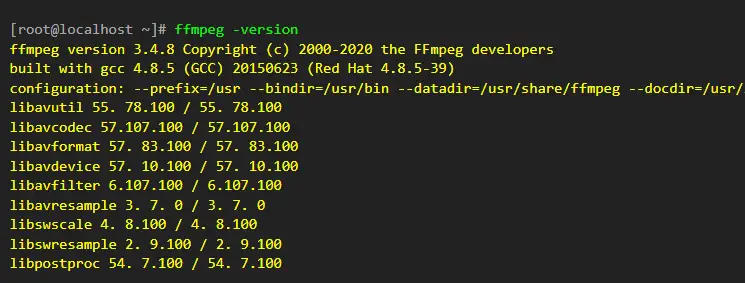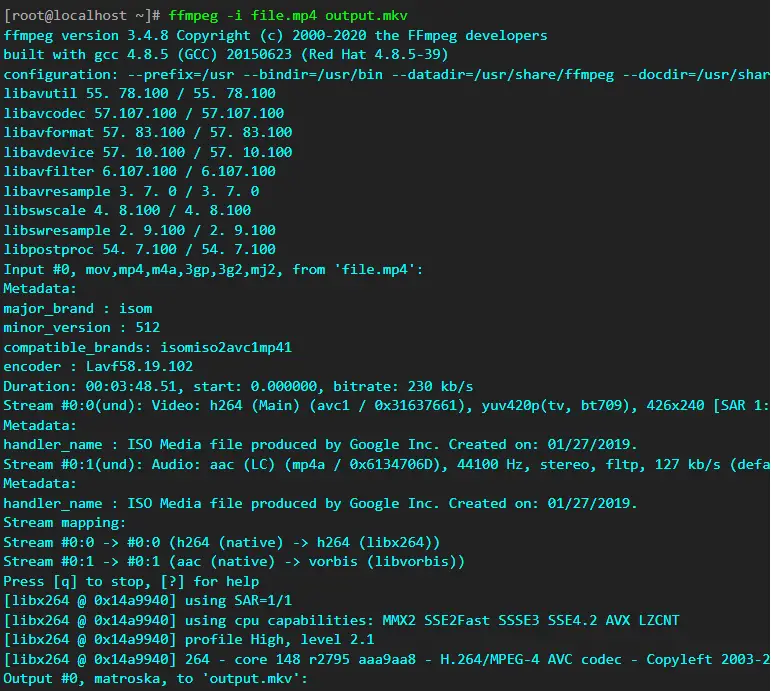FFmpeg is a free, open-source software library for handling and processing multimedia files. It is famous on Linux (and other platforms) because it provides a powerful and versatile set of tools for encoding, decoding, and processing audio and video files.
FFmpeg can be used to convert media files from one format to another, extract audio or video tracks, capture video from a webcam, and much more. It supports a wide variety of input and output formats and has a strong community of developers and users who contribute to its development and maintenance.
It is widely used by many open-source and commercial applications, including video editors, media players, and transcoding software. The fact that it is free and open-source makes it an attractive option for many developers, and its widespread use has contributed to its popularity on Linux.
Additionally, its powerful feature set and ease of use have made it a popular choice for media processing and conversion tasks on Linux and other platforms.
FFMPEG Features
FFmpeg is a powerful and versatile multimedia processing software that has a wide range of features and capabilities. Here are some of the most notable features of FFmpeg:
- Support for a wide range of audio and video formats: It supports a wide variety of audio and video formats, including popular formats such as MP3, MP4, AVI, FLAC, and many more.
- Encoding and decoding: FFmpeg can be used to encode and decode audio and video files, allowing you to convert media files from one format to another.
- Filtering and processing: The software provides a wide range of filters and processing options for audio and video, including video scaling, color correction, and audio normalization.
- Stream processing: FFmpeg can be used to process live video and audio streams, making it a popular choice for streaming video and audio over the internet.
- Batch processing: FFmpeg provides batch processing capabilities, allowing you to process multiple files in a single command.
- Command-line interface: It also has a powerful command-line interface that allows you to perform a wide range of multimedia processing tasks, including encoding, decoding, filtering, and more.
- Community support: FFmpeg has a large and active community of developers and users who contribute to its development and maintenance, ensuring that the software remains up-to-date and functional.
Can You Use FFMPEG on CentOS?
Yes, you can use FFmpeg on CentOS. FFmpeg is available for many different operating systems, including Linux, Windows, and macOS, and it can be installed on CentOS using the package manager or by building it from source.
FFmpeg is a free, open-source software that can be used to encode, decode, transcode, filter, and process audio and video files. To install FFmpeg on CentOS, you’ll need to use the command line. Here’s a step-by-step guide:
The very first step is to; Update the system:
sudo yum update
Install the necessary packages:
sudo yum install epel-release yum-utils
Add the FFmpeg repository:
sudo yum-config-manager --add-repo https://negativo17.org/repos/epel-7/negativo17-epel-7.repo
Install FFmpeg:
sudo yum install ffmpeg
Verify the installation by checking the version of FFmpeg:
ffmpeg –version

Now that you have FFmpeg installed on your system, you can start using it. To use FFmpeg, you’ll need to enter commands in the terminal. Here are some basic examples of how to use FFmpeg:
Convert an audio file from one format to another:
ffmpeg -i input.mp3 output.m4a
Convert a video file from one format to another:
ffmpeg -i input.mp4 output.mkv
Extract the audio from a video file:
ffmpeg -i input.mp4 -vn -acodec copy output.m4a
These are just a few basic examples of what you can do with this software. There are many more advanced options and features that you can explore as you get more familiar with the tool. For more information we recommend visiting Computingforgeeks.
Summary
CentOS is known for its stability and long-term support, making it a popular choice for servers and critical applications. When combined with FFmpeg, it is a reliable and stable software for video and audio processing, providing robust solution for various video and audio processing tasks. We recommend our users to use FFmpeg on CentOS once, and you can see the difference by yourself.
In conclusion, the combination of FFmpeg and CentOS can provide a stable, reliable, and customizable solution for various GUI and audio processing needs, with the added benefit of large community support and scalability.
